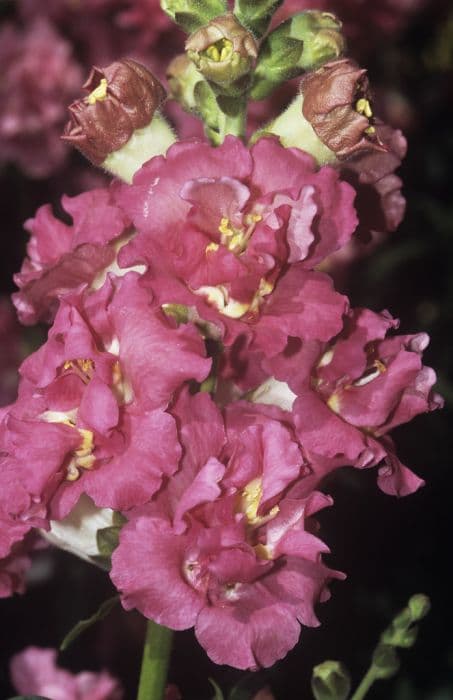Speedwell Veronica spicata

ABOUT
Veronica spicata, commonly known as Spike Speedwell, is a flowering perennial plant with a striking and lush appearance. It's characterized by its narrow spikes of densely packed flowers that present a visual spectacle throughout the blooming season. These flowers come in a variety of shades, including blues, purples, and occasionally pinks and whites, offering a cooling palette to any garden landscape. The foliage of Spike Speedwell is equally attractive, forming a low mound or rosette of oblong to lance-shaped leaves that can be either smooth or have a slightly toothed edge. The leaves are a rich green color, which beautifully sets off the vibrancy of the flowers. Veining may be visible upon closer inspection of the leaves, adding subtle detail to the plant's overall texture. The stems of Spike Speedwell are sturdy and upright, holding the flower spikes aloft with grace and providing an elegant vertical element to plantings. These stems, along with the vibrant flower spikes, create an alluring contrast against the softer, more mounded foliage below, lending both texture and height contrast to gardens and borders without regard to their actual size. Due to its attractive flower spikes, Spike Speedwell is often used as a focal point in garden designs and is widely appreciated by pollinators such as bees and butterflies. Its propensity for producing a profusion of blooms makes it a favorite among garden enthusiasts who seek to add long-lasting color and form throughout the flowering season. As the blooms begin to fade, they can be cut back to encourage a second flush of flowers, ensuring a display that persists for an extended period. In summary, Spike Speedwell is known for its vibrant, pointed flower spikes, lush green foliage, and its ability to add texture, color, and vertical interest to a variety of garden settings, all the while drawing in beneficial wildlife with its nectar-rich blooms.
About this plant
 Names
NamesSynonyms
Spike Speedwell, Spiked Speedwell, Creeping Veronica
Common names
Pseudolysimachion spicatum, Veronica spicata subsp. spicata, Veronica spicata var. spicata.
 Toxicity
ToxicityTo humans
Veronica spicata, commonly known as Spike Speedwell, is not considered toxic to humans. There are no well-documented toxic effects or symptomatic poisonings associated with ingesting this plant. Therefore, accidental ingestion is not likely to cause harm, though it is generally not advisable to consume plants not specifically grown for consumption due to possible pesticide contamination or misidentification.
To pets
Spike Speedwell is also not considered toxic to pets. It is not known to cause any significant toxicity or symptoms of poisoning in animals such as dogs or cats if they ingest parts of the plant. While ingestion of non-food plants can sometimes lead to mild gastrointestinal upset in pets, Spike Speedwell does not have a reputation for being problematic in this regard. As with humans, it is always best to prevent pets from consuming plants not intended for their diet.
 Characteristics
CharacteristicsLife cycle
Perennials
Foliage type
Deciduous
Color of leaves
Green
Flower color
Blue
Height
1-2 feet (30-60 cm)
Spread
1-2 feet (30-60 cm)
Plant type
Herb
Hardiness zones
3-8
Native area
Europe
Benefits
 General Benefits
General Benefits- Attracts Pollinators: Veronica spicata is known for attracting bees and butterflies, which are pivotal for the pollination of many plants and crops.
- Low Maintenance: It's a hardy perennial that requires minimal care once established, making it a good choice for gardeners of all skill levels.
- Drought Tolerance: Once established, it can tolerate periods of drought, reducing the need for frequent watering.
- Aesthetic Appeal: With its spiky blooms and vibrant colors, it adds visual interest and beauty to gardens and landscapes.
- Ground Cover: It can act as a ground cover, suppressing weeds and reducing soil erosion.
- Long Blooming: Veronica spicata has a long blooming season, often from early summer to early fall, providing a consistent display of color.
- Versatile Landscaping: Suitable for borders, rock gardens, and as edging plants, it's versatile for various landscaping designs.
- Cold Tolerant: It is able to withstand cold temperatures, making it suitable for gardens in cooler climates.
- Fauna Shelter: The plant's growth habit can provide shelter for small creatures like insects and ground-nesting birds.
 Medical Properties
Medical Properties- Anti-inflammatory: Veronica spicata has traditionally been used for its anti-inflammatory properties.
- Astringent: The plant may possess astringent properties that can help constrict tissues and reduce secretions.
- Diuretic: It has been considered to have diuretic effects, promoting the production of urine and thus aiding in the removal of waste from the body.
- Expectorant: Veronica spicata is believed to act as an expectorant, helping to clear mucus from the respiratory tract.
- Antiseptic: There are some beliefs that the plant holds antiseptic properties, which could help prevent the growth of microorganisms.
 Air-purifying Qualities
Air-purifying QualitiesThis plant is not specifically known for air purifying qualities.
 Other Uses
Other Uses- Decorative dried flowers: The flower spikes of Veronica spicata, also known as Speedwell, can be dried and used in floral arrangements for a rustic or cottage-style aesthetic.
- Natural fabric dye: The vivid colors of Speedwell flowers can be used to naturally dye fabrics and textiles with shades of blue or purple, depending on the mordant used.
- Garden border plant: With its dense foliage and tall flower spikes, Speedwell can create an attractive and defined edge along garden paths and borders.
- Groundcover: Speedwell can serve as groundcover in garden beds, helping to suppress weeds and maintain soil moisture.
- Wildlife attraction: Speedwell flowers are known to attract butterflies, bees, and other beneficial pollinators to the garden.
- Erosion control: The robust root system of Speedwell can help stabilize soil on slopes and prevent erosion.
- Garden companion plant: Speedwell is believed to be a good companion for roses and other perennials by attracting beneficial insects and adding height contrast.
- Craft projects: The colorful flower spikes can be used in crafting projects such as making bookmarks, greeting cards, or pressed flower art.
- Lawn alternative: In some settings, Speedwell can be used as a low-maintenance, flowering lawn alternative that requires less water and mowing than traditional grasses.
- Photographic subject: The striking appearance of Speedwell, whether in bloom or as part of the larger garden landscape, makes it a popular choice for garden photographers and nature enthusiasts.
Interesting Facts
 Feng Shui
Feng ShuiThe Veronica spicata, commonly known as Speedwell, is not used in Feng Shui practice.
 Zodiac Sign Compitability
Zodiac Sign CompitabilitySpeedwell is not used in astrology practice.
 Plant Symbolism
Plant Symbolism- Fidelity: Veronica spicata, commonly known as Speedwell, symbolizes faithfulness and loyalty, often used in floral arrangements to portray a message of steadfastness in love.
- Healing: Historically, Speedwell has been associated with healing due to its use in herbal medicine for various ailments, symbolizing the wish for recovery and good health.
- Protection: Speedwell is thought to offer spiritual protection and ward off negativity; it is sometimes planted in gardens with the belief that it will protect the area and those within it.
 Water
WaterThe Veronica spicata, commonly known as Spike Speedwell, should be watered regularly to maintain consistent soil moisture, especially during its first growing season to establish a deep root system. Once established, it's somewhat drought-tolerant and requires less frequent watering. During the growing season, water the Spike Speedwell about once a week, providing approximately one inch of water each time. Adjust the frequency depending on the weather conditions; during periods of drought or extreme heat, the plant may require additional water. Always avoid overhead watering to prevent leaf diseases and water at the base of the plant instead.
 Light
LightSpike Speedwell thrives best in full sun to partial shade. Ideally, it should receive at least six hours of direct sunlight daily, but it can also do well in a spot that gets a mix of sun and light shade throughout the day. Avoid deep shade, as this can lead to poor flowering and a leggy growth habit.
 Temperature
TemperatureSpike Speedwell is hardy and can tolerate a range of temperatures. It prefers a temperate climate, with the ideal growing temperatures being between 60 and 70 degrees Fahrenheit. The plant can survive minimum winter temperatures down to -20 degrees Fahrenheit but may need protection from harsh winter conditions. The maximum temperature should not exceed 85 degrees Fahrenheit for prolonged periods as this can stress the plant.
 Pruning
PruningPruning Spike Speedwell is important for encouraging bushier growth and more robust flowering. Deadhead the spent blooms throughout the blooming season to promote continuous flowering. After the main blooming period is over, cut back the flower spikes by about half their height to potentially encourage a second, though smaller, flush of flowers. The best time for major pruning is late winter or early spring, before new growth begins.
 Cleaning
CleaningAs needed
 Soil
SoilSpeedwell (Veronica spicata) thrives in well-draining soil enriched with compost and a balanced pH of 6.0 to 7.0. A mix of garden soil, compost, and perlite or sand is ideal for facilitating good drainage and nutrient retention.
 Repotting
RepottingSpeedwell does not require frequent repotting and can be repotted every 2-3 years or when the plant has clearly outgrown its current container.
 Humidity & Misting
Humidity & MistingSpeedwell prefers moderate humidity levels but is adaptable and can tolerate the varying humidity levels commonly found in temperate regions.
 Suitable locations
Suitable locationsIndoor
Place Speedwell in bright, indirect light, and ensure good air circulation.
Outdoor
Plant Speedwell in full sun to partial shade; ensure soil drainage.
Hardiness zone
3-8 USDA
 Life cycle
Life cycleVeronica spicata, commonly known as Spike Speedwell, begins its life cycle as a seed, typically germinating in the spring when soil temperatures increase. Upon germination, the seedling emerges and develops a rosette of leaves at the soil surface. As the plant grows, it develops a strong root system and vegetative growth, with stems elongating and leaves maturing. Flowering occurs in early to mid-summer, presenting tall, narrow spikes of small, densely-packed flowers that are usually blue, violet, or white in color. After pollination by insects, the flowers produce small capsules containing seeds, completing the reproductive phase. As a perennial plant, Spike Speedwell will enter a period of dormancy in autumn, with above-ground growth dying back, and it will regenerate from its rootstock the following spring.
 Propogation
PropogationPropogation time
Spring to summer
Propogation: The most popular method of propagation for Veronica spicata, commonly known as Spike Speedwell, is by division. This method typically takes place in the spring or early fall. Dividing the plant involves digging up an established clump and carefully separating the root ball into smaller sections, each with several shoots and a healthy portion of roots attached. These sections are then replanted at the same depth they were growing at before and watered thoroughly. This ensures a high success rate as division maintains the established root system, allowing the plant to recover and grow quickly after transplanting. It's essential to water the new plants regularly until they are fully established.





![Snapdragon [Pretty in Pink]](/_next/image?url=https%3A%2F%2Fplants-admin.emdemapps.com%2Fimages%2Fplants%2F%2Fimages%2F604b5cb3b5385.png&w=640&q=75)



